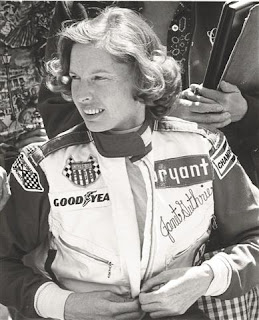Unlike many female racers today, Janet Guthrie didn't start out a racecar driver. She started out a physicist, with a bachelor's degree from the University of Michigan, and a pilot, logging hours in the air as early as 13 and making a parachute jump at 16. She applied for NASA's scientist-astronaut program in 1964 and made it through the first round of eliminations.
But when she needed a car, she didn't purchase just any four-wheeled contraption. She bought a 1953 Jaguar XK120 M coupé (for those of you who don't know, it's NICE) and she started competing in local hill climbs, rallies, and gymkhanas with it. Her skill and interest in racing increased, and by 1972, she was racing full time.
She explained, "I think it's just in some people's nature to want to find out what it's like out there at the edge of human capabilities, and fortunately I was born in the machine age when broad shoulders and big muscles didn't make that much difference – didn't make any difference, in fact"
(IOP interview).
In the mid-1970s, a long-time team owner and car builder, Rolla Vollstedt, offered her the chance to race his cars. With his support, between 1976 and 1977, Guthrie became the first woman to compete in a NASCAR Cup series race, the first woman to compete in the Daytona 500—as well as the race's top rookie—and the first woman to qualify for and compete in the Indy 500.
She faced plenty of resistance. Race fans told her they hoped she'd crash. Drivers suggested the reason she didn't qualify for Indy in 1976 was due to her gender (and kudos to AJ Foyt for being angry enough at those comments to offer Guthrie a test in his own backup car). The legendary Richard Petty was quoted as saying, "She's no lady. If she was, she'd be at home. There's a lot of differences in being a lady and being a woman."
As Guthrie explains, "The only way to deal with that stuff was on the race track; there was no other way to deal with it. As long as I had a car to drive, I figured I could handle whatever came with the territory" (NASCAR.com).
Janet Guthrie proved herself on the track, racking up two class wins at the 12 Hours of Sebring, finishing sixth at Bristol (NASCAR), and ninth in the Indy 500. (Given how well she did with very few starts and limited funding, it's only a shame she didn't have more, and better-funded, cars to drive.) What she accomplished paved the way for more women to follow.
(Photo from JanetGuthrie.com.)
Wednesday, March 29, 2017
Subscribe to:
Posts (Atom)


